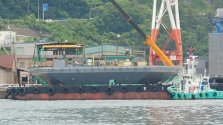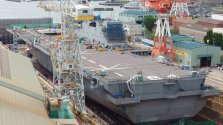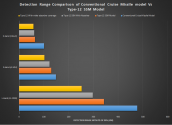You are using an out of date browser. It may not display this or other websites correctly.
You should upgrade or use an alternative browser.
You should upgrade or use an alternative browser.
Kumamo testing the elevation and depression of her main Mk-45 5” gun.
One speculation which I'm not quite sure how credible from an engineering standpoint, so feel free to chime in, is that the bow as originally designed for the trapezoidal foredeck would be incompatible with the new flight deck due to inherently different properties in buoyancy, esp. when taking into a/c the existing bow sonar, so much so that it means modifying not just the flight deck but the whole bow, perhaps with additional or rearranged ballasts to ensure proper stability with the new deck.The bow of JMSDF JS Kaga [DDH-184] has evidently been removed by the ship yard.
Leonardo, Mitsubishi to collaborate on radar technology demonstration
By andJul 18, 10:36 PM
:quality(70)/cloudfront-us-east-1.images.arcpublishing.com/mco/ZGIDWQJZUBGLXIRU7IPSDLUTPI.jpg)
Leonardo UK's radar portfolio includes an Mk 2 Eurofighter system that is reportedly optimized for electronic warfare and traditional radar tasks. (Leonardo UK)
FARNBOROUGH, England — Leonardo UK and Mitsubishi Electric agreed to collaborate on a radar technology demonstrator concept that could inform future joint development efforts between the U.K. and Japan.
The agreement, announced July 18 at the Farnborough Airshow in England, follows the completion of joint concept and feasibility studies between the companies this year and signifies approval from their respective national defense ministries to move forward with the program, they said.
Britain and Japan have deepened their partnership on air combat technology in recent years. In December, the nations signed a Memorandum of Cooperation indicating their intent to collaborate on combat aircraft. Reuters reported last week that the countries could decide to merge their by the end of the year. Japan’s program is called F-X and Britain’s is the Future Combat Air System, or FCAS.
Leonardo UK, a radar and electronics company, is part of the Team Tempest, the industry group the U.K. assembled to begin developing its advanced fighter capabilities. In a statement, the company indicated the radar program, called Jaguar, may be the start of more combat aircraft collaboration between the countries.
“Jaguar represents the first big building block of an international radar program that meets the ambitions laid out by Japan and the UK as part of F-X/FCAS discussions,” Leonardo UK said.
Jaguar will feed into development of Tempest’s Integrated Sensing and Non-Kinetic Effects & Integrated Communications System, which is designed to bring together multiple sensor capabilities, the company said.
This might be speculative but. a modeling on Radar Cross Section of Type-12SSM project. The missile image is based on available Japanese document release.
Currently the tweet only shows result for PEC (Non treated) model. But i already have result for expected RCS when radar absorber treatment is applied. Also for now it's limited to frontal aspect but i guess it is relevant. The modeling also includes (but speculative) internals of the inlet which include a small Jet engine model. The modeling frequency range is from VHF Frequency (0.15 GHz) down to Ku/Ka wave (35 GHz) Which hopefully enough coverage for most Radars from early warning down to SPAAG fire control radar.
The treated model covers several assumptions :
1.Airframe treatment
2.More comprehensive treatment
3."chin" only treatment where only relevant part of the airframe which apparent contributor in RCS flare spots are treated.
All models have control surfaces treated. The material used for treatment is a Nickel-Zinc-Ferrite Absorber compound as mentioned in "Radar Cross Section 2nd Edition". 3 mm thickness is selected based on experience and practicality. That this compound is relatively heavy and application of high thickness of such compound may compromise the missile in terms of range and handling.
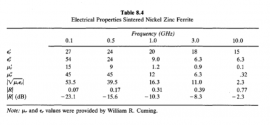
Modeling example in X-band (9.15 GHz)
From left to right :
1.PEC model, 2.Body-Wing-Tail only treatment 3.More comprehensive treatment now include nose, 4.Chin, part of airframe, wing, tail and inlet diverter treatment only.

Notice that "Chin" only treatment have kind of similar effect as more comprehensive treatment. Although in general it still have kind of higher RCS but not very noticeable at least qualitatively. The following depicts the MEDIAN frontal aspect RCS of each types of treatments along with conventional cruise missile model :
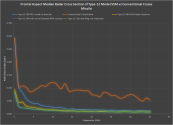
One can notice the "chin only" treatment in green line correspond to similar level of RCS reduction along with more comprehensive treatment. This is in accordance to "wisdom" that Absorber is used to treat "special flare spot" to cover one's area of concern.
Reduction in range wise is roughly 47% compared to conventional airframe. Thus Type-12 with RAM treatment will be detected in Half the range a radar platform may detect conventional cruise missile. As depicted below
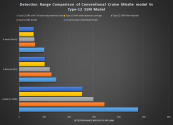
The Chin only treatment seems to offer more payoff having the same effect as more comprehensive treatment but with probable weight and maintenance advantage compared to one with more comprehensive treatment.
Currently the tweet only shows result for PEC (Non treated) model. But i already have result for expected RCS when radar absorber treatment is applied. Also for now it's limited to frontal aspect but i guess it is relevant. The modeling also includes (but speculative) internals of the inlet which include a small Jet engine model. The modeling frequency range is from VHF Frequency (0.15 GHz) down to Ku/Ka wave (35 GHz) Which hopefully enough coverage for most Radars from early warning down to SPAAG fire control radar.
The treated model covers several assumptions :
1.Airframe treatment
2.More comprehensive treatment
3."chin" only treatment where only relevant part of the airframe which apparent contributor in RCS flare spots are treated.
All models have control surfaces treated. The material used for treatment is a Nickel-Zinc-Ferrite Absorber compound as mentioned in "Radar Cross Section 2nd Edition". 3 mm thickness is selected based on experience and practicality. That this compound is relatively heavy and application of high thickness of such compound may compromise the missile in terms of range and handling.

Modeling example in X-band (9.15 GHz)
From left to right :
1.PEC model, 2.Body-Wing-Tail only treatment 3.More comprehensive treatment now include nose, 4.Chin, part of airframe, wing, tail and inlet diverter treatment only.

Notice that "Chin" only treatment have kind of similar effect as more comprehensive treatment. Although in general it still have kind of higher RCS but not very noticeable at least qualitatively. The following depicts the MEDIAN frontal aspect RCS of each types of treatments along with conventional cruise missile model :

One can notice the "chin only" treatment in green line correspond to similar level of RCS reduction along with more comprehensive treatment. This is in accordance to "wisdom" that Absorber is used to treat "special flare spot" to cover one's area of concern.
Reduction in range wise is roughly 47% compared to conventional airframe. Thus Type-12 with RAM treatment will be detected in Half the range a radar platform may detect conventional cruise missile. As depicted below

The Chin only treatment seems to offer more payoff having the same effect as more comprehensive treatment but with probable weight and maintenance advantage compared to one with more comprehensive treatment.
Attachments
SamuraiBlue
Captain
Very much meaningless if you ask me. The type 12SSM is a trans-sonic missile that flies low, sea skimming to it's target so it will be mostly below the horizon. It will also be hard to detect due to noise clutter from above as well due to random reflection of radar waves from the sea surface.This might be speculative but. a modeling on Radar Cross Section of Type-12SSM project. The missile image is based on available Japanese document release.
Currently the tweet only shows result for PEC (Non treated) model. But i already have result for expected RCS when radar absorber treatment is applied. Also for now it's limited to frontal aspect but i guess it is relevant. The modeling also includes (but speculative) internals of the inlet which include a small Jet engine model. The modeling frequency range is from VHF Frequency (0.15 GHz) down to Ku/Ka wave (35 GHz) Which hopefully enough coverage for most Radars from early warning down to SPAAG fire control radar.
The treated model covers several assumptions :
1.Airframe treatment
2.More comprehensive treatment
3."chin" only treatment where only relevant part of the airframe which apparent contributor in RCS flare spots are treated.
All models have control surfaces treated. The material used for treatment is a Nickel-Zinc-Ferrite Absorber compound as mentioned in "Radar Cross Section 2nd Edition". 3 mm thickness is selected based on experience and practicality. That this compound is relatively heavy and application of high thickness of such compound may compromise the missile in terms of range and handling.
View attachment 94938
Modeling example in X-band (9.15 GHz)
From left to right :
1.PEC model, 2.Body-Wing-Tail only treatment 3.More comprehensive treatment now include nose, 4.Chin, part of airframe, wing, tail and inlet diverter treatment only.

Notice that "Chin" only treatment have kind of similar effect as more comprehensive treatment. Although in general it still have kind of higher RCS but not very noticeable at least qualitatively. The following depicts the MEDIAN frontal aspect RCS of each types of treatments along with conventional cruise missile model :
View attachment 94939
One can notice the "chin only" treatment in green line correspond to similar level of RCS reduction along with more comprehensive treatment. This is in accordance to "wisdom" that Absorber is used to treat "special flare spot" to cover one's area of concern.
Reduction in range wise is roughly 47% compared to conventional airframe. Thus Type-12 with RAM treatment will be detected in Half the range a radar platform may detect conventional cruise missile. As depicted below
View attachment 94941
The Chin only treatment seems to offer more payoff having the same effect as more comprehensive treatment but with probable weight and maintenance advantage compared to one with more comprehensive treatment.
The smaller your distinguishable return is, the more noise clutter obscures you.Very much meaningless if you ask me. The type 12SSM is a trans-sonic missile that flies low, sea skimming to it's target so it will be mostly below the horizon. It will also be hard to detect due to noise clutter from above as well due to random reflection of radar waves from the sea surface.
Interview with a female ex-JGSDF member who was inspired to join up after witnessing rescue efforts by the Self-Defense Forces in her home town during Tohoku 2011.
As soon as she finished training, however, she was subjected to daily sexual harassment, abuse and direct assault from her peers and superiors, to the point she nearly committed suicide, only to be interrupted by a call to duty as an earthquake struck.
Reports were brought up, and dismissed on grounds of being "part of the training". Charges were subsequently filed, likewise dropped on grounds of "lack of evidence" as witnesses were "ordered" not to testify.
The JSDF has a high suicide rate due to the extreme hierarchical and conformal structure within the forces.
The mental and physical "toughness" that are expected from service members mean that abuses that would otherwise be illegal are often unreported, outright ignored and tolerated in order to preserve "unit cohesion".
Enable CC for Eng subs -
As soon as she finished training, however, she was subjected to daily sexual harassment, abuse and direct assault from her peers and superiors, to the point she nearly committed suicide, only to be interrupted by a call to duty as an earthquake struck.
Reports were brought up, and dismissed on grounds of being "part of the training". Charges were subsequently filed, likewise dropped on grounds of "lack of evidence" as witnesses were "ordered" not to testify.
The JSDF has a high suicide rate due to the extreme hierarchical and conformal structure within the forces.
The mental and physical "toughness" that are expected from service members mean that abuses that would otherwise be illegal are often unreported, outright ignored and tolerated in order to preserve "unit cohesion".
Enable CC for Eng subs -
lol, 15 people made their testimonies before the court in a sexual harassment case and no one confirmed her version. Sure. "because Japan is hierarchical society" lolReports were brought up, and dismissed on grounds of being "part of the training". Charges were subsequently filed, likewise dropped on grounds of "lack of evidence" as witnesses were "ordered" not to testify.
Until someone's proven guilty in the court I would always be extremely careful in those cases. No matter if it's Japan, US, PRC or any other country in the world. There's been so many imaginary and false cases of 'sexual harassment' made by women that it's mind boggling. Looks like one of those cases.
To follow up, the woman's case is now making national news, and the MoD has opened a new investigation into the matter -Interview with a female ex-JGSDF member who was inspired to join up after witnessing rescue efforts by the Self-Defense Forces in her home town during Tohoku 2011.
As soon as she finished training, however, she was subjected to daily sexual harassment, abuse and direct assault from her peers and superiors, to the point she nearly committed suicide, only to be interrupted by a call to duty as an earthquake struck.
Reports were brought up, and dismissed on grounds of being "part of the training". Charges were subsequently filed, likewise dropped on grounds of "lack of evidence" as witnesses were "ordered" not to testify.
The JSDF has a high suicide rate due to the extreme hierarchical and conformal structure within the forces.
The mental and physical "toughness" that are expected from service members mean that abuses that would otherwise be illegal are often unreported, outright ignored and tolerated in order to preserve "unit cohesion".
Enable CC for Eng subs -

